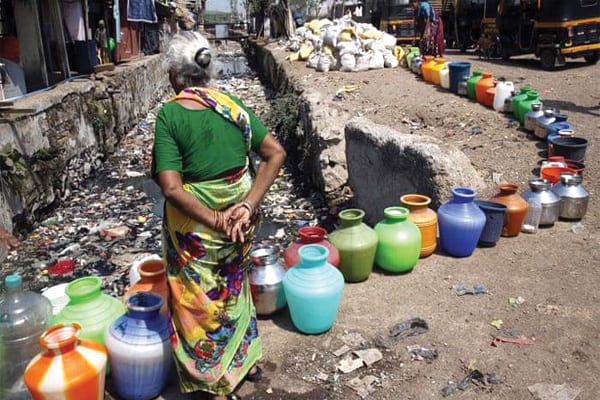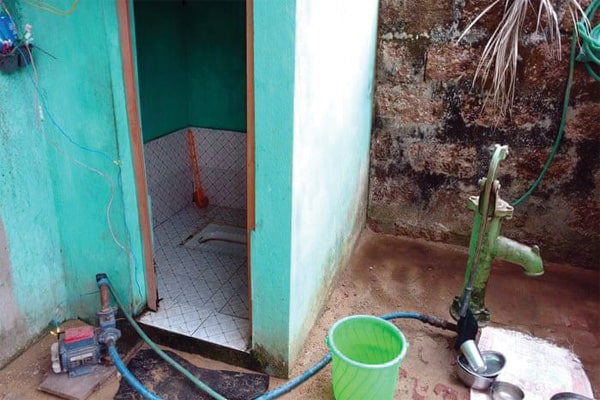
One in every six of the Indian population lives in unauthorised colonies, and almost 95 million people live in these colonies. Out of the 93 million habitants, 80 per cent have inadequate access to sanitation, as per the 2008-09 National Sample Survey Organisation (NSSO), writes Lovlesh Sharma, Senior Water and Infrastructure Expert, W&E Vertical, Sector Coordinator Infrastructure, Master Plan Delhi (MPD-2041), NIUA.

Figure 1: Slum in Mumbai, India
The existence of unauthorised colonies
The uncontrolled migration of rural population in Urban centres has been a basic cause for the formation of unauthorised settlements in Indian cities. One in every six of the Indian population lives in unauthorised colonies, and almost 95 million people live in these colonies. The major locations of these settlements are unutilised space of the city like river flood plains, edges of railway tracks etc. As per Un-Habitat 2008 report, almost half of the world’s slum population resides in Asia, while in India, approx 45 per cent of urban households are classified as slums.

Surprisingly, out of the 93 million habitants of unauthorised colonies in India, 80 per cent have inadequate access to sanitation, as per the 2008- 09 National Sample Survey Organisation (NSSO). Interestingly, Delhi is a peculiar case in this regard, even being the capital of India, more than 40 per cent of its population still lives in unplanned colonies. However, the unauthorised colonies are, in a way, possible solutions to the homeless households in urban areas. At the same time, the unplanned nature of these settlements leads to most critical issues including access to clean water, inadequate sanitation and lack of other basic amenities.



Difficulty in infrastructure provisioning for urban local bodies
The basic challenge in unauthorised colonies is the absence of basic amenities required for the liveability. The very unplanned nature creates the first issues, as the formation of these settlements has been inorganic and unplanned, no civic amenities could be planned timely. In most of the cases, the provisioning of basic services in unauthorised colonies is an afterthought or remedial attempt. The unavailability of space to put the trunk and branch infrastructure is the core issue. As far as the drinking water supply is concerned, the household somehow gets access to it. This may be through the community taps, ground water withdrawal or access to tankers supply. The criticality arises when it comes to the sanitation facilities to these households. The inadequate facilities for sanitation make these pockets more vulnerable and challenging. For the Urban Local Bodies, the main issue is the unavailability to provide sanitation facilities.

Poor state of basic services in unauthorised colonies
Poor access to sanitation facilities in these unauthorised colonies make the situation worse not only due to inadequate provisioning, but the impact of the improper wastewater management. The sewage generated from these colonies add to the local drains making them full with untreated sewage. The vector borne diseases and the mixing of untreated sewage in ground water causes many health hazards to the habitants of these colonies. Moreover, the improperly- constructed toilet blocks have led to the health issue of several people in the unauthorised colonies across the country. The local bodies at times try their level best to arrange for the community toilet access, but considering the population density in Indian cities, it is again a tough task. Most of the households in unauthorised colonies have a system of septic tank base sanitation. This is a regular practice in rural as well as unauthorised colonies. Many planned areas in urban centres also have septic tank-based sanitation system.
The universal myth that the sewered system is the only correct way for sanitation is questioned well in the Indian context. A big chunk of Indian cities still function well with septic tanks. There are two big challenges with septic tank-based sanitation. First is the improper and incorrect design of septic tanks and the unavailability of Faecal Sludge Management System (FSSM) in the cities. Unauthorised colonies too majorly rely upon poorly designed septic tanks base sanitation. The wrongly designed septic tanks are a threat to the health of residents in many ways. The vector borne disease due to contamination of groundwater is most critical.
The kind of diseases poor sanitation leads to is scary, for instance diarrhoea, water diseases, parasitic worms/ infestation and faecal oral diseases etc, are really a big threat to life for the habitants. It is widely mismanaged in India and it might be the worst sanitation country in the world for unauthorised countries. Moreover, the children are the most affected ones and because of these epidemics, the mortality rate of children is huge.

Case of Delhi
More than 45 per cent of Delhi residents live in unplanned colonies, and most of them face serious sanitation crisis from exposed drains to rampant open defecation. A study conducted by the Delhi government in 2012 revealed that close to 56 per cent of children in unauthorised settlements defecate in the open, exposing them to a greater risk of contracting infections and contagious diseases. Intermittent strikes by sanitation staff have severely affected the regular cleaning of the drains which have, over time, turned into community health hazards, compounding the crisis further. It has been recorded that while 36.6 per cent of households had open drainage systems in the national capital, 4.2 per cent households had no drainage at all.
Also Read | Effective management of wastewater is the key to managing urban rivers
However, Master Plan Delhi envisages laying of sewer lines in a length of about 10,500 km, which is a lengthy process. Hence, the work is to be carried out in a phased manner, prioritising areas where sewer lines can be made functional, immediately after being laid, because of availability of outfall sewers and wastewater treatment plants. The unavailability of proper sanitation system in Delhi’s unauthorised colonies has created several health hazards for the residents and the various reports indicate huge loss of lives due to the same cause.
Recommendation
However, the Swachh Bharat Abhiyan (Clean India Mission) has resulted in major improvements in access to safe potable water, sanitation, and hygiene facilities, especially in urban India. But still, the city administrations in India need to plan the hybrid sanitation system especially for unplanned pockets. The areas where sewerage lines are difficult to lay down, the septage management has to be made foolproof. The community toilet system can also be a useful way to maintain the health and hygiene of these areas. Moreover, the improved knowledge of proper design of septic tanks and its benefits. Most of the planned urban areas witness the improper septic tank designs. The other issue with non- sewered areas is irregular de-sludging. The local bodies need to create an ecosystem for the scheduled and demand de-sludging of septic tanks. The app-based system as adopted by many Indian cities can be a game changer. The health and hygiene of the habitants of unauthorised colonies can be best managed by the proper facility of drinking water and sanitation services.

The redevelopment of unplanned colonies is a long term process, city administration has to plan basic services to these urban-poor strategically, so as to reduce the case of water borne diseases and health hazards. The hybrid of sewerage and septage has changed the fabric of many unplanned colonies across the world. Awareness about safe sanitation practices is also a key factor which cities need to target upon. The knowledge of right practice and behaviour about correct sanitation practice will also offload the pressure of local bodies.
Be a part of Elets Collaborative Initiatives. Join Us for Upcoming Events and explore business opportunities. Like us on Facebook , connect with us on LinkedIn and follow us on Twitter, Instagram.











